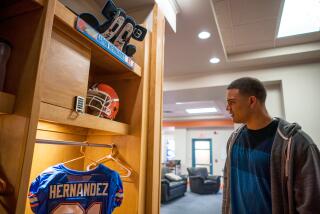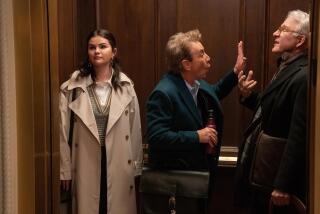When the plot pushes product
THE nation’s future was at stake and Jack Bauer, as usual, was racing against the clock on last month’s season premiere of “24.” Stuck in an airport crawl space, he could only watch helplessly as the enemy terrorized hostages and made demands of the president.
Fortunately, the writers made sure the maverick agent had a fully charged camera phone. The sponsors made sure it was a Sprint Treo 650.
Bauer even offered a testimonial to his colleagues at headquarters: “I’m going to send you photos of the hostages. They should be clear enough for you to identify them.”
Welcome to the world of product integration. More subtle than product placement -- the time-honored practice of having “American Idol” judges drinking from Coca-Cola cups, say -- the rising alternative to commercials actually weaves products into plots and dialogue of some of television’s top prime-time scripted shows.
According to Nielsen Media Research, which has been tracking product placements the last three years, the number of placements, including the new integration, jumped 30% to 108,261 last year. NBC ranked highest with 7,470 instances of a product being shown on its reality show “The Contender” alone and an additional 3,009 placement shots on “The Apprentice.”
Product integration efforts can be as obvious as Eva Longoria taking work as a spokesmodel for Buick on “Desperate Housewives,” or as subversive as the cast of “Arrested Development” making fun of Burger King at a Burger King.
Television, of course, has historically served as a vehicle for advertising. But knowing that sponsors are paying for the boss of “The Office” (Steve Carell) to frequent Chili’s and order his “awesome blossom” “extra awesome” might shock some viewers who have grown used to believing scripted programs are pure creative efforts separated by 30-second commercials.
On one episode of “The Office,” Carell’s character broke into the restaurant’s catchy “baby back ribs” jingle while entertaining a potential client there. Stars of “Veronica Mars” and “The O.C.” are frequently shown using their T-Mobile Sidekicks to solve mysteries or thicken the plot.
“We’re living in a crazy new world,” said Gary Newman, president of 20th Century Fox Television, which produces “24.” “The old formulas don’t necessarily work. We have to be smart and find new ways to monetize the value of our programs,” he said.
Networks have joined companies and producers in the scramble to offset the anticipated decline of the 30-second commercial, threatened by the avalanche of technological novelties that allow consumers to control their entertainment on iPods, cellphones or the Internet.
There is no standard model for placements; in some cases, story lines involving a specific product are pitched to a relevant company that can then buy its product’s way into the scene; in other cases, companies suggest their products for a show. One Los Angeles broker has set up a matchmaking website so potential partners can find one another. Another company has specialized in digitally inserting brands into films and shows, allowing entertainment companies to sell the same space several times: On one film, for instance, one advertiser appeared in theaters, another on network television, another on basic cable and still another on DVD.
Costs range “all over the map,” depending on the number of episodes and what the production is asked to do with the product, said Tom Meyer, president of Davie-Brown Entertainment, whose clients have paid for more than 50 placements and integrations. “A car manufacturer might be willing to pay $100,000 to $150,000 to show the mirror turns upside down. Going in and completely crafting a whole segment from scratch where the brand is a key player could be a million bucks.” As the level of control over the message goes down, so does the cost. “If it’s subliminal, it’s not worth quite as much,” he said.
“It really feels like a win-win,” Newman said. “What we have to be careful about is not overdoing it.” He said Toyota financed new scenes shot for a two-season DVD of “24” in which Jack and colleague Chloe each drove a Toyota. The villains tended to drive another type of car.
Producer Ben Silverman said “The Restaurant” accelerated the trend in 2003 by using advertisers, including American Express, Coors and Mitsubishi, to fully finance the show in return for playing a visible role in the televised day-to-day work of entrepreneur Rocco DiSpirito. Producers then sold the show to NBC. “It enabled us to make a show we couldn’t get financed in a traditional way. NBC and NBC Universal Television chief Jeff Zucker were open to trying an alternative way to get a new kind of programming on the air,” Silverman said. He has since produced four more shows fully financed by brands.
No quantitative studies have yet proven the effect of product integration.
Complaints by consumer and writers’ groups that the practice is turning prime-time shows into infomercials have been largely ignored in the rush to keep pace with the rapidly evolving technology and younger viewers’ resistance to being a passive, captive audience for commercials.
Those viewers, the 8-to-28 group known to marketers as “millennials,” tend to be cynical about traditional commercials, which they regard as lectures, said Jack MacKenzie, a senior vice president at Frank N. Magid Associates, a media and entertainment research and consulting firm. On the other hand, MacKenzie said that millennials actually give credit to companies that come up with new and creative forms of selling to them.
Not only are they adept with the record, fast forward and pause buttons, he said, they also understand their role as valuable targets for companies who want them to buy things. “They understand that better than any other generation that has preceded them,” MacKenzie said. “They’ve been sold to by cable TV and custom magazines since they were 10 years old.”
Rather than sending a subliminal message, the best integrations encourage their savvy young viewers to join them in the joke, he said.
One particularly creative approach appeared in an episode of “Arrested Development” in which a fictional product integration takes place within a real product integration. In the scene, set in a Burger King, actor Carl Weathers, playing a version of himself, told acting student Tobias (David Cross) that Burger King would underwrite his TV project if he set a scene in the restaurant. Catching on, Tobias replied, “As long as you don’t draw attention to it.” Weathers then pointedly mentioned that soft drink refills are free at Burger King, prompting Tobias to exclaim, “It’s a wonderful restaurant!” The narrator chimed in: “It sure is.”
“In terms of their image, Burger King is willing to have fun with themselves in a way they believe the consumer finds engaging. On the basis of sales, they’ve been proven right,” said Peter Tortorici, who left his job as president of CBS Entertainment to head Group M, a media buying agency that represents Burger King among others.
He said the best integrations match “the sensibility of a program to brand sensibility. It has more to do with subtext than with seeing a product.” As the sponsor of “Extreme Makeover: Home Edition,” Sears Roebuck & Co. delivers its products to a makeover site in clearly labeled Sears trucks. The company can say its products are about “quality-of-life experiences, generosity, can-do attitude and community. The program in its narrative embodies those things,” Tortorici said.
Similarly, the show “7th Heaven” worked Campbell’s soup into a story line in which Ruthie Camden collects labels for a school benefit.
“24” fans are obviously more interested in seeing Jack Bauer save the world than transmit photographs. Accordingly, later in the premiere episode, his Treo camera phone played a key role in vanquishing the enemy: A specialist back at headquarters “reconfigured” the device so that Jack could use it to detonate a vest explosive worn by a terrorist.
“Not every tactic works equally,” Tortorici said, “but the overall strategy is clearly successful.”
Many marketers have predicted viewers would be seeing more product integration in scripted and reality shows, but that the technique will likely “self-regulate” before it compromises the creative process and turns off viewers with too many products, plugged too obviously.
In the end, some said, integration may be so time-consuming, and take so much effort and collaboration, it probably would not replace the 30-second spot. “The beauty of the 30-second spot is that it’s portable, you can put it anywhere you want,” said Davie-Brown’s Meyers.
And perhaps significantly, the majority of millennials (54%) recently polled by Magid said they would be more likely to buy a video iPod and watch a 30-second advertisement in return for a free download of a favorite television program. The alternative, it was implied, would be to pay for downloads free of commercials.
*
Ready for their close-up
For product placement in action, watch Jack Bauer use a Sprint video phone while chasing terrorists in “24” and “The Office’s” Michael Scott shows up at a Chili’s restaurant. Go to www.calendarlive.com/stealth
More to Read
The biggest entertainment stories
Get our big stories about Hollywood, film, television, music, arts, culture and more right in your inbox as soon as they publish.
You may occasionally receive promotional content from the Los Angeles Times.










